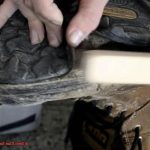Are you in the midst of a home renovation and pondering over the best type of flooring for your space? If you’re considering a floating floor, you may be wondering if it’s possible to glue it down for added stability. This is a common query that often confuses homeowners who are looking for the most suitable installation method for their floating floor.
Before we delve into the answer, let’s first understand what a floating floor is. A floating floor is an innovative type of flooring installation that doesn’t attach to the subfloor but instead rests on top of it. The individual pieces snap or click together to create a seamless unit.
Now, when it comes to gluing a floating floor down, there are several factors to consider. Firstly, the type of floating floor you have will determine whether it can be glued down or not. Secondly, your existing subfloor’s condition and type will also play a crucial role in deciding whether gluing down your floating floor is the best option.
So, can you glue down a floating floor? The answer is yes, but only under certain circumstances. To learn more about when gluing down a floating floor is appropriate and what considerations you should make before making this decision, keep reading.
What is a Floating Floor?
Contents
- 1 What is a Floating Floor?
- 2 Benefits of Glue-Down Floating Floors
- 3 Potential Drawbacks of Glue-Down Floating Floors
- 4 How to Prepare the Subfloor for Glue Down Installation
- 5 Choosing the Right Adhesive for a Glue-Down Installation
- 6 Tips for Installing a Glue-Down Floating Floor
- 7 How to Maintain Your Glued Down Floating Floor
- 8 Pros and Cons of Using Glue for a Floating Floor Installation
- 9 Conclusion
A floating floor is a type of flooring that is not directly attached to the subfloor. Instead, it “floats” on top of an underlayment made of foam or cork. The planks or tiles are interlocked or clicked together at the edges, creating a stable and durable surface. This type of flooring is popular due to its ease of installation and affordability compared to traditional glued down floors.
There are several materials that can be used for floating floors, including laminate, engineered hardwood, luxury vinyl plank, and cork. Each type has its own unique characteristics, such as durability or moisture resistance, making it important to choose the best fit for your specific needs.
One of the benefits of a floating floor is its versatility. It can be installed over various types of subfloors, including concrete, plywood, and even existing flooring. Additionally, it can be easily removed or replaced without damaging the subfloor.
However, before deciding to glue down your floating floor, it’s crucial to consider the potential downsides. Gluing down the planks can make repairs and replacements more difficult in the future, and removing glued-down planks can be time-consuming and labor-intensive.
It’s important to note that not all floating floors can be glued down. This is because some manufacturers may not recommend gluing down their products due to potential damage or voiding of warranties. Always follow the manufacturer’s instructions and recommendations for installation.
Benefits of Glue-Down Floating Floors
As an expert in this field, I want to share with you the many benefits of this installation method and why it’s worth considering for your home or business.
Firstly, glue-down floating floors offer superior stability and security compared to traditional floating floors. With direct attachment to the subfloor, they don’t shift or move as much over time, preventing unsightly and potentially hazardous gaps between planks or tiles. This added stability makes them perfect for high traffic areas, where heavy foot traffic can cause traditional floating floors to shift.
In addition to their stability, glue-down floating floors provide excellent sound insulation. The direct attachment to the subfloor means there’s less space for sound to travel through, reducing noise levels in the room. This feature is especially important in multi-story buildings where noise can easily travel between floors.
Not only are glue-down floating floors stable and quiet, but they’re also easy to clean and maintain. Without any gaps between planks or tiles, dirt and debris can’t get trapped, making it a breeze to sweep or vacuum the floor. Plus, the lack of gaps makes it less prone to staining, making it a durable choice for your flooring needs.
Potential Drawbacks of Glue-Down Floating Floors
When contemplating the installation of a floating floor, it may be tempting to consider the option of gluing it down instead of using the traditional click-and-lock method. However, it is important to take a deeper look at the potential drawbacks before making a decision.
Firstly, one major concern with glue-down floating floors is their permanence. Unlike click-and-lock floors, which can be easily removed and replaced if necessary, glued-down floors become a permanent fixture in your space. If you ever need to make repairs or replace the flooring altogether, you’ll have to go through the arduous and expensive process of removing the glued-down planks.
In addition to the challenge of removal, moisture damage is another potential issue. Since a glued-down floor is directly adhered to the subfloor, any moisture that gets trapped underneath can cause warping or buckling over time. This can be especially problematic in areas with high humidity levels or where spills and leaks are common.
Finally, using glue to secure your floating floor can be messy and time-consuming. Each plank must be individually coated with glue and carefully placed on the subfloor to ensure even distribution. Any mistakes made during installation could result in an uneven or improperly secured floor.
Overall, while gluing down a floating floor may seem like an attractive option initially, it’s important to weigh the potential drawbacks against the convenience. To recap:
- Glued-down floors are permanent and difficult to remove.
- Moisture damage is more likely with glued-down floors.
- Installation can be messy and time-consuming.
How to Prepare the Subfloor for Glue Down Installation
Preparing your subfloor for a glue-down installation of a floating floor is crucial for ensuring its longevity and stability. It requires attention to detail and careful planning. Below are five sub-sections on how to prepare your subfloor for a successful installation:
Clean the Subfloor Thoroughly
Before starting the installation process, it’s vital to thoroughly clean the subfloor to remove any dirt, dust, or debris that could affect the adhesion of the glue. Use a broom or vacuum cleaner to sweep the area carefully.
Inspect and Level the Subfloor
Inspect the subfloor for any damage or unevenness. High spots or irregularities must be sanded down or filled with a self-leveling compound to ensure a flat surface. Uneven subfloors can cause gaps, bubbles, and shifting of the flooring over time.
Check the Moisture Level of the Subfloor
To ensure proper adhesion, it’s essential to know the moisture content of your subfloor using a moisture meter. If it’s above 12%, you may need to install a vapor barrier to prevent moisture from seeping into the flooring.
Apply a Primer on the Subfloor
Before gluing down your floating floor, it’s recommended that you apply a primer on the subfloor. The primer helps increase adhesion, particularly on porous surfaces like concrete or plywood. Allow it to dry completely before applying any glue.
Apply Adhesive Evenly and Plan Your Layout Carefully
Choose the correct adhesive type for your flooring and apply it evenly using a trowel or roller according to the manufacturer’s instructions. Plan out the layout and direction of your planks or tiles carefully before laying them down. This will help minimize waste and ensure an aesthetically pleasing installation.
Choosing the Right Adhesive for a Glue-Down Installation
If you opt for a glue-down installation, choosing the right adhesive is critical to ensure a successful outcome. As an expert in this field, let me guide you through the factors to consider when selecting an adhesive for a glue-down installation that will provide a durable and attractive flooring solution for your home or business.
Firstly, you need to determine the type of floating floor you have as different adhesives work better for different types of flooring. For instance, if you have an engineered wood or laminate floating floor, you must select an adhesive specifically designed for these types of floors.
Secondly, the subfloor where your flooring will be installed plays a crucial role in deciding the right adhesive. The adhesive you choose must be compatible with the material and condition of your subfloor. For example, if you are installing over a concrete subfloor, you require an adhesive that can withstand moisture and has strong bonding properties.
Additionally, environmental conditions such as high humidity and temperature fluctuations also impact your adhesive choice. If your installation area experiences these conditions, you need an adhesive that can withstand these without compromising its performance.
It’s imperative to read the manufacturer’s instructions carefully and follow them closely when selecting an adhesive. Using the wrong adhesive or applying it incorrectly can lead to a failed installation and costly repairs.
Tips for Installing a Glue-Down Floating Floor
A glue-down floating floor is a great option for homeowners who want added stability and sound reduction. However, it’s important to follow some tips to ensure that the installation process goes smoothly and that your new floor looks beautiful and lasts for years to come.
Prep Your Subfloor with Care
Proper subfloor preparation is crucial for a successful glue-down installation. Be sure to sweep or vacuum your subfloor to remove any dirt or debris. Fill in any cracks or holes with a suitable filler and use a self-leveling compound if your subfloor is uneven. This will ensure that your flooring adheres properly and looks great.
Choose the Right Adhesive
Choosing the right adhesive is crucial for a successful glue-down installation. Make sure you choose an adhesive that is recommended for your specific type of flooring and subfloor material. Read the manufacturer’s instructions carefully to ensure that you’re using the right product, and check the recommended temperature and humidity levels for installation.
Spread Adhesive Evenly and Work in Small Sections
Use a trowel to spread the adhesive evenly over the subfloor, being careful not to apply too much adhesive. Working in small sections will allow you to focus on one area at a time and ensure that each section is installed correctly before moving on to the next.
Use Spacers for Consistent Gaps
Spacers can help you maintain a consistent gap between planks as you install them, ensuring that your floor looks uniform and preventing any issues with expansion and contraction. Be sure to remove the spacers once the adhesive has dried.
Use a Roller for Strong Adhesion
Once you lay each plank or tile, use a roller to press it firmly into the adhesive and ensure good contact. This will help prevent air pockets from forming under the flooring and ensure a strong bond.
How to Maintain Your Glued Down Floating Floor
Maintaining a glued down floating floor is essential to ensure its longevity and beauty. Here are five sub-sections that detail the steps necessary to properly maintain your glued down floating floor.
Regular Cleaning
To keep your glued down floating floor in top condition, regular cleaning is crucial. Sweep or vacuum the surface to remove loose dirt, dust, and debris that can scratch or damage the surface. Use a soft-bristled broom or vacuum with a hard floor attachment for effective cleaning.
Use the Right Cleaning Solution
Avoid harsh chemicals or abrasive materials that can damage the adhesive bond between the floor and the subfloor. Instead, use a mild cleaning solution specifically designed for floating floors. Excessive moisture can also cause damage, so avoid using excessive water when cleaning your floor or placing wet items on the surface.
Prompt Issue Resolution
Address any issues promptly to prevent further damage and maintain the stability of your glued down floating floor. Loose or damaged planks or tiles should be repaired as soon as possible to ensure that your floor remains safe to walk on.
Prevent Scratches and Dents
Preventing scratches and dents is another critical aspect of maintaining your glued down floating floor. Place felt pads under furniture legs to prevent them from scratching the surface of your floor, and avoid wearing high heels or shoes with hard soles on your floor. These small steps can go a long way in keeping your floor looking its best.

Repair Minor Damage
Despite regular maintenance, scratches and dents can still occur over time. Fortunately, there are several DIY solutions for repairing minor damage. For small scratches or gouges, use wood filler to fill in the area and sand it smooth once it dries. For more extensive damage, you may need to replace individual planks or hire a professional to refinish the entire floor.
Pros and Cons of Using Glue for a Floating Floor Installation
While the click-lock method is more popular, gluing down your floating floor has its own set of benefits and drawbacks. As an expert in the field, let me break down the pros and cons of using glue for a floating floor installation.
Let’s start with the pros. One significant advantage of gluing down your floating floor is stability. By using glue, you can reduce movement between the planks, resulting in a more solid feel underfoot. Moreover, gluing down the planks can improve sound reduction by minimizing the space for sound to travel between them. Another benefit of using glue is that it can help seal the edges of the planks, providing better moisture resistance and reducing the risk of water damage.
However, there are also some cons to consider. Gluing down a floating floor can be more time-consuming than using a click-lock method because each plank needs to be glued individually. This can be especially challenging if you’re working with a large space or an intricate pattern. Additionally, glued-down planks are more challenging to remove than those that are clicked together, making repairs or replacement more difficult. Finally, using glue can be more expensive than using a click-lock method because you need to purchase both the adhesive and the applicator.
It’s important to weigh these factors against your specific needs and budget before making a decision. Here are some sub-topics to consider:
- Stability: If you’re looking for a sturdy and more solid feel underfoot, then gluing down your floating floor may be the way to go.
- Sound Reduction: If you’re installing a floating floor in an area where noise reduction is essential, then gluing down your planks may help minimize sound transfer between them.
- Moisture Resistance: If you’re installing a floating floor in an area prone to moisture exposure like a bathroom or basement, gluing down your planks can help seal the edges and prevent water damage.
- Time: If you have a tight schedule or a large space to cover, using glue may not be the best option for you as it can be more time-consuming than a click-lock method.
- Difficulty of Removal: If you anticipate the need for future repairs or replacement, consider that glued-down planks are more challenging to remove than those that are clicked together.
l7p2ubU269s” >
Conclusion
In conclusion, a floating floor may seem like a simple solution for homeowners looking for an easy and affordable flooring option. However, when it comes to adding stability through gluing down the floating floor, there are several important factors to consider.
Firstly, different types of floating floors have varying recommendations from manufacturers regarding gluing them down. Additionally, the condition and type of the subfloor play a crucial role in determining whether gluing down the floating floor is appropriate.
While glue-down floating floors offer superior stability, sound insulation, and ease of maintenance compared to traditional floating floors, they also have potential drawbacks such as permanence, moisture damage, and messy installation. Therefore, it’s essential to carefully weigh these factors against convenience before making a decision.
If you do decide to glue down your floating floor, proper preparation of the subfloor is paramount for ensuring its longevity and stability. Choosing the right adhesive for your specific type of flooring and subfloor material is also critical for success.
In summary, while gluing down a floating floor may provide added benefits initially, it’s important to consider all factors involved before making a final decision.






